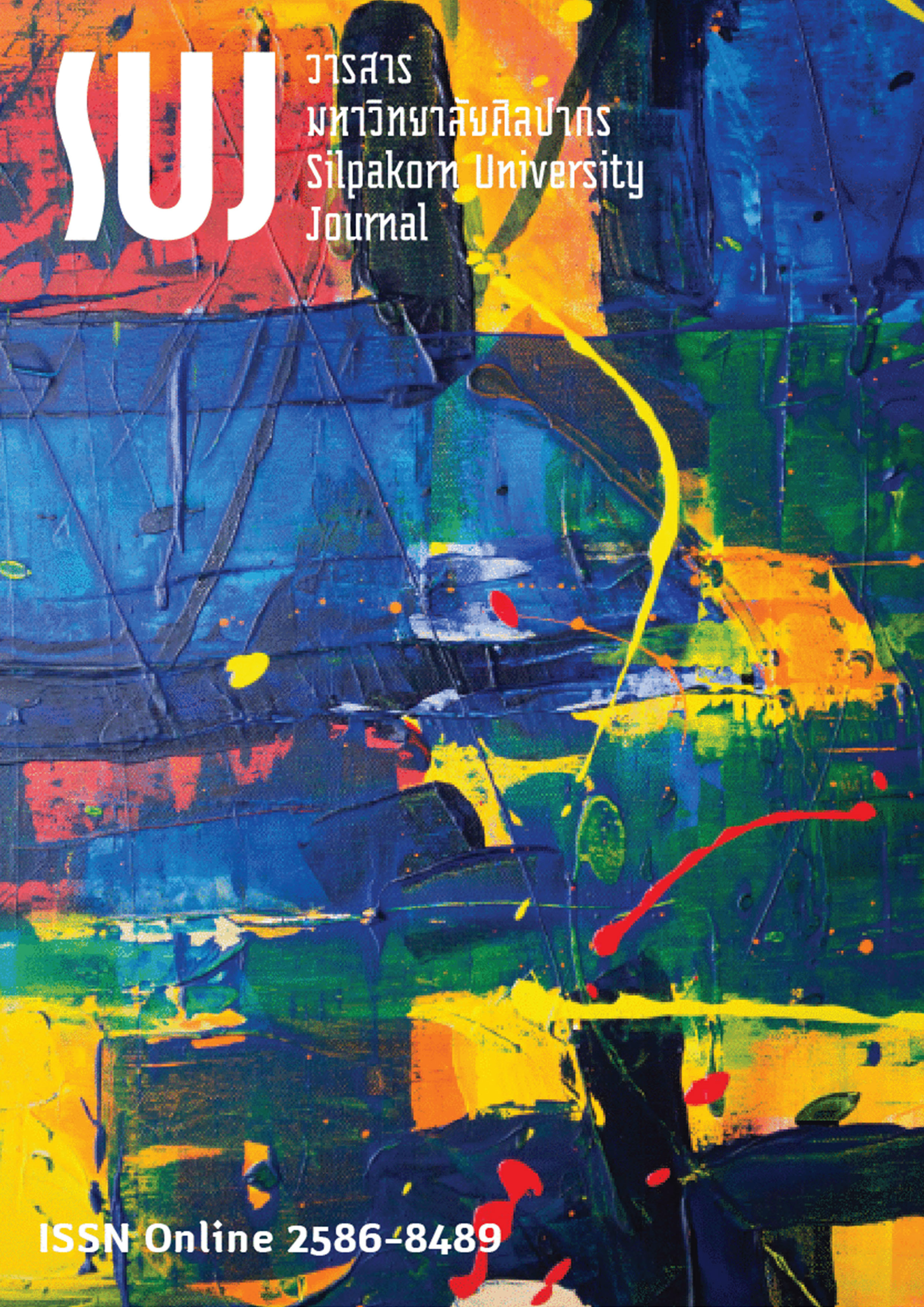การศึกษาเชิงวิเคราะห์สุนทรียภาพทางภาษาในจารึกวัดศรีชุม (An analytical study of language aesthetics in inscription of Wat śrī Chum)
Main Article Content
Abstract
จารึกวัดศรีชุม หรือจารึกสุโขทัยหลักที่ 2 บันทึกความศรัทธาและการบำเพ็ญบุญบารมีของสมเด็จพระมหาเถรศรีศรัทธาราชจุฬามุนีฯ ผ่านการสื่อความหมายสุนทรียภาพทางภาษา บทความนี้จึงมีวัตถุประสงค์เพื่อศึกษาวิเคราะห์ให้เห็นมิติสุนทรียภาพทางภาษาในจารึกหลักนี้ว่ามีความหมายและความสำคัญอย่างไร ผลการศึกษาพบว่า สุนทรียภาพทางภาษาในจารึกวัดศรีชุม จำแนกเป็น 4 ลักษณะ คือ 1) สุนทรียภาพทางภาษาเกี่ยวกับสิ่งมีชีวิต แสดงให้เห็นถึงความงามของสิ่งมีชีวิตที่เป็นมนุษย์ คือ สมเด็จพระมหาเถรศรีศรัทธาราชจุฬามุนีฯ พระธิดาและพระชายาของพระศรีศรัทธาราชจุฬามุนีฯ รวมทั้งชาวสิงหล ความงามของสิ่งมีชีวิตที่เป็นสัตว์ คือ ฝูงสัตว์ที่สมเด็จพระมหาเถระฯ ปลดปล่อยให้เป็นทาน 2) สุนทรียภาพทางภาษาเกี่ยวกับธรรมชาติ ดังที่จารึกเน้นความงามของต้นไม้ 3) สุนทรียภาพทางภาษาเกี่ยวกับภาวะเหนือธรรมชาติ จารึกพรรณนาให้เห็นความมหัศจรรย์ของพระมหาธาตุ 4) สุนทรียภาพทางภาษาเกี่ยวกับศิลปกรรมที่ช่างสร้างสรรค์อย่างวิจิตร ได้แก่ รูปฉลัก พระพุทธรูป และบังลังก์มหาธาตุ มิติสุนทรียภาพทางภาษาดังกล่าวผู้เล่าเรื่องใช้ภาษาสื่อความหมายประจำคำหรือความหมายตรงตัวว่า“งาม” “งามหนักหนา” และ “งามพิจิตรหนักหนา”และความหมายแฝงหรือความหมายโดยเปรียบเทียบกับสิ่งที่งาม จากการศึกษาในครั้งนี้ ก่อให้เกิดประโยชน์ด้านจารึกศึกษา ช่วยให้อ่านและตีความจารึกวัดศรีชุม โดยเฉพาะการเน้นย้ำแนวคิดสุนทรียภาพทางภาษา และประโยชน์ด้านพระพุทธศาสนา ทำให้เข้าใจบริบทความเชื่อพระพุทธศาสนาในยุคสมัยสุโขทัย
The interpretations of the language aesthetics of the inscription of Wat śrī Chum which is known as the 2nd of Sukhothai Inscription shows that the inscription marked the faith and meritorious deeds of Somdet Phra Mahāthera śrī śaddhā Rājacuḷāmunī. This study aimed to study and analyze how this inscription is meaningful and important. The language aesthetics in the inscription could be classified into 4 aspects: 1) the language aesthetics of living things, demonstrating aesthetics of humans that refers to Somdet Phra Mahāthera śrī śaddhā Rājacuḷāmunī, his wife, and his daughter, including Sinhalese people and the aesthetics of animals which Somdet Phra Mahāthera śrī śaddhā Rājacuḷāmunī released from cages for Dāna; 2) the language aesthetics of nature as emphasized in the inscription about beauty of plants; 3) the language aesthetics of supernatural beings, describing a miracle of Phramahāthāt; and 4) the language aesthetics of artistry reflected through artistic objects created by artists such as an image of the Lord Buddha and Phramahāthāt’s bench sculpture. The storyteller illustrates the authentic dimension of beauty and conveys literal meaning with the words ”beautiful,” along with the use of some figurative language or modifiers such as ”stunning”, and ”spectacular” to emphasize the beauty. The benefits of this study contributes to the epigraphy studies in reading and solving the inscription of Wat Sri Chum. Particularly, it underlines the significance of language aesthetics and Buddhist pragmatism as it offers greater understanding of the context about Buddhist beliefs in Sukhothai Era.
Downloads
Article Details

This work is licensed under a Creative Commons Attribution-NonCommercial-NoDerivatives 4.0 International License.
References
Anchaleenukoon, Sunant. (2019). Thai word system (ระบบคำภาษาไทย). Bangkok: Chulalongkorn Press.
Bhirasri, Silpa. (1994). Aksorn Silpa Bhirasri (อักษรศิลป์ พีระศรี). Bangkok: Thai Arts Information Center.
Chittasutthiyan, Supot. (2021). Introduction to Aesthetics (สุนทรียศาสตร์เบื้องต้น). Bangkok: Chulalongkorn Press.
Ittaratana, Chuanpis. (1975). A Study of Thai words and idiomatic expressions in the Sukhothai period (การใช้คำและสำนวนในสมัยสุโขทัย). Master’s dissertation, Chulalongkorn University, Bangkok, Thailand.
Kamdee, Duan. (2013). The Role of Faith and Wisdom to Attain Ultimate Truth (บทบาทของศรัทธาและปัญญาในการบรรลุสัจธรรม). The Journal of the Royal Institute of Thailand, 38(4): 17-46.
Na Nagara, Prasert. (2004). Inscriptions of the Sukhothai period (การอธิบายศิลาจารึกสมัยสุโขทัย). Nonthaburi: Sukhothai Thammathirat Open University Printing House.
Na Nagara, Prasert. (2006). Alphabet, Language, Inscription, Literature (อักษร ภาษา จารึกวรรณกรรม รวมบทนิพนธ์ “เสาหลักทางวิชาการ” ของศาสตราจารย์ ดร.ประเสริฐ ณ นคร). Bangok: Matichon Publishing House.
Pichard, Pierre. (2009).The Mondop at Wat Si Chum : New Perspectives Part 1 (มณฑป วัดศรีชุม : มุมมองใหม่ ส่วนที่ 1). NAJUA: History of Architecture and Thai Architecture, 6(2009): 71-86.
Pongsripian, Vinai. (2009). Document No. 2 Inscription of Wat Si Chum (เอกสารลำดับที่ 2 จารึกวัดศรีชุม). In 100 key documents: essence of Thai history No.1, (pp.37-95) Bangkok: Thailand Research Fund.
Princess Maha Chakri Sirindhorn Foundation. (2011). Encyclopedia King of Thai (นามานุกรมพระมหากษัตริย์ไทย). Bangkok: Princess Maha Chakri Sirindhorn Foundation.
Soonpongsri, Kamchorn. (2013). Aesthetics, Philosophy, Criticism (สุนทรียศาสตร์ หลักปรัชญาศิลปะ ทฤษฏีทัศนศิลป์ ศิลปวิจารณ์). Bangkok: Chulalongkorn Press.
The Royal Society. (2013). Thai Dictionary of the Royal Institute 2011 (พจนานุกรมฉบับราชบัณฑิตยสถาน พ.ศ. 2554). Bangkok: The Royal Society.
The Royal Society. (2020). Dictionary of the Ancient (พจนานุกรมโบราณศัพท์ ฉบับราชบัณฑิตยสภา). Bangkok: The Royal Society.
The Fine Arts Department. (1984a) Sukhothai Inscription number II (Inscription of Wat śrī Chum) (ศิลาจารึกสุโขทัยหลักที่ 2 จารึกวัดศรีชุมพร้อมคำอธิบายของคณะกรรมการพิจารณา และจัดพิมพ์เอกสารทางประวัติศาสตร์ สำนักนายกรัฐมนตรี พ.ศ. 2521). Bangkok: The Fine Arts Department.
The Fine Arts Department. (1984b). Sukhothai Inscription number II (Inscription of Wat śrī Chum) (ศิลาจารึกสุโขทัยหลักที่ 2 (จารึกวัดศรีชุม) ฉบับผลการสัมมนา พ.ศ. 2523). Bangkok: The Fine Arts Department.
The Fine Arts Department. (2005). The Collection of Inscriptions volume 8 (ประชุมจารึกภาคที่ 8 จารึกสุโขทัย). Bangkok: The Fine Arts Department.
Vajiravudh, King Rama VI. (2011). Travels in Phra Ruang Country (เที่ยวเมืองพระร่วง). Bangkok : Chulalongkorn Press.
Wright, Michael. (1986). Inscription number II (Wat Si Chum) New reading method (ศิลาจารึกสุโขทัยหลักที่ 2 (วัดศรีชุม) วิธีอ่านใหม่). Bangkok: Thai Khadi Research Institute, Thammasat University.


